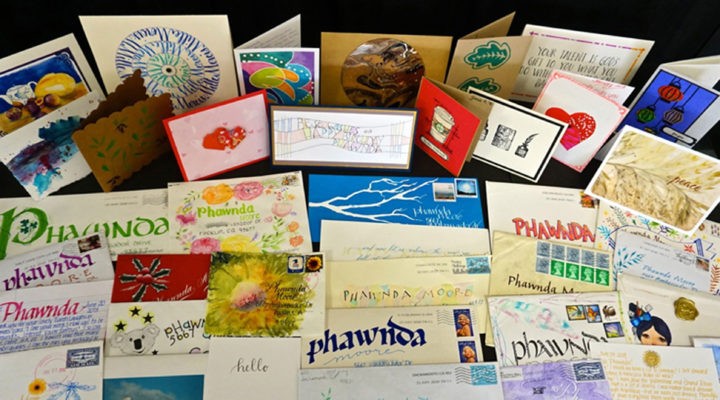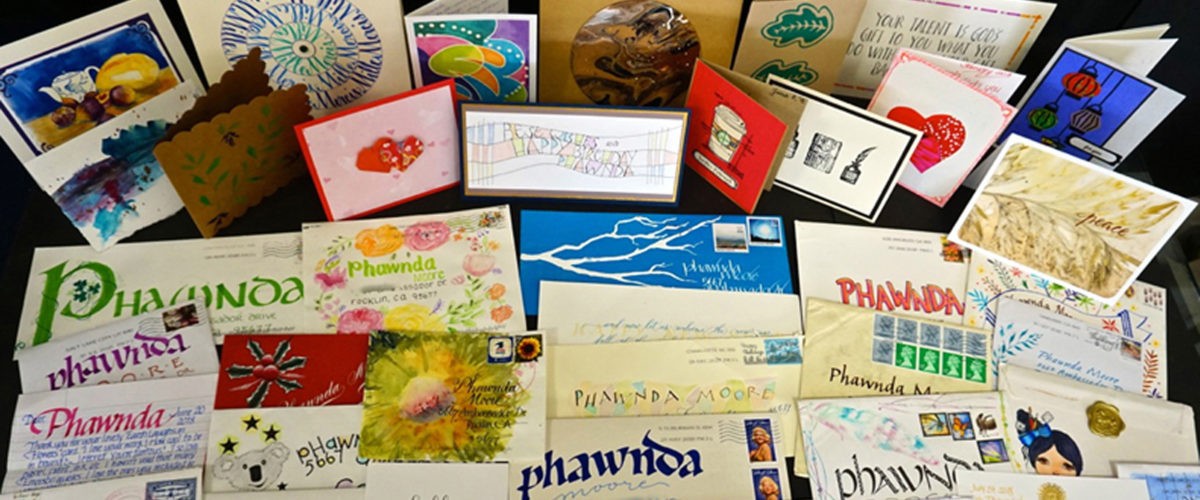Handwriting is capable of traveling around the world, enduring the harrowing journey of postal automation, weather and human error to reach its destination. It’s known to survive many generations of readers. Just about everyone has saved a letter, recipe or card from a special person or event.
Reading someone else’s unique handwriting somehow brings you closer to them, perhaps with a vision of their face, remembering the scent of their perfume, the sound of their words or the sense of their touch.

Phawnda Moore
As the quarantine continues, the value of a letter or even a postcard increases. So, many are creating and sending old-fashioned letters; they’re proof that another person validates a friendship, love and connection. You go to the post box and one day find a special envelope amid bills, publications and bulk rate ads. Tell me which one catches your eye.
Many folks say receiving a letter from someone they miss makes their day. And these days, with so many in service who go beyond the extra mile, sending a hand-addressed postcard is a gracious touch. These can be printed four-up on 8.5 x 11-inch heavier laser paper and cut into quarters. They also may be handed out at the market with a smile or given to delivery folks with a thank you.
Even if I weren’t a calligrapher, I’d still write letters. This pastime began in my teens and was encouraged by my family; good handwriting was an accomplishment. We sent thank you notes for gifts and reached out to share life with those at a distance. At the time it seemed ordinary and was a simple thing to do at the dining room table.
Decades of life have brought other ways to communicate. But nothing ever replaces a hand-addressed letter.
 My college art professor was also a letter writer. Lucky me, after graduation, we somehow began writing to each other. It was a thrill to get every one of his letters, carefully and beautifully created, often in simple pencil or ballpoint pen. However, he and I both noticed that on occasion, he misspelled my name and he always corrected it with an apology. But it still happened. After many years, we found humor in this. Recently he included an entire practice sheet of “Phawnda”, spelled correctly (and beautifully written). I’m married to “Ron,” so in the lower corner, was a single “Ron” followed by “nailed it!”
My college art professor was also a letter writer. Lucky me, after graduation, we somehow began writing to each other. It was a thrill to get every one of his letters, carefully and beautifully created, often in simple pencil or ballpoint pen. However, he and I both noticed that on occasion, he misspelled my name and he always corrected it with an apology. But it still happened. After many years, we found humor in this. Recently he included an entire practice sheet of “Phawnda”, spelled correctly (and beautifully written). I’m married to “Ron,” so in the lower corner, was a single “Ron” followed by “nailed it!”
“Mail Art” is a term for a specially designed envelope. And anyone can do it with paper and pencil and about 30 minutes of time. Correspondence is more enjoyable with a nice fountain pen and scented or colored ink, or one’s favorite writing tool. And then, there’s nice stationery and postage stamps, washi tape (decorative) or rubber stamps. Adding a little illustration or color makes it an art form.
Youngsters learning to write have a natural interest in corresponding with pen pals — often with those in other countries. Exchanging stamps is interesting, too. The benefits of corresponding tend to improve not only handwriting and creativity but also an understanding of geography and cultures.
So pick up your favorite writing tool and give it a try. You can draw hearts or flowers or stars. Send encouraging words and terms of endearment. It’s our chance to bring more beauty and hope to the world these challenging days.
Phawnda Moore is author of Lettering from A to Z. She lives in Northern California, where she coordinates international mail art exchanges. Find her on Facebook at Calligraphy & Design by Phawnda or Instagram at phawnda.moore.


